A show of ‘quiet and intriguing discoveries’
3 July 2014
Tailings Dam by Pip McManus (video and editing) and Nic Hempel (cello). This video was part of a live performance on opening night.
By KIERAN FINNANE
A show of “light and dark”, of “quiet and intriguing discoveries”, that “answers questions and poses them”, is how Helen Maxwell OAM, art consultant and valuer, described Groundrush, an exhibition at the Araluen Arts Centre that opened last Friday.
It grew out of the work of six artists who took part in a residency at the Groundrush mine in the Tanami Desert in 2007. They are Rachel Bowak, Nic Hempel, Kim Mahood, Andrew Moynihan, Pip McManus and Pamela Lofts, who dubbed themselves ‘The Budgies’ for the fluoro-green ‘budgie’ vests they were required to wear on site.
For Lofts the show is posthumous – she died in 2012 – and it is presented as a memorial to her. She was a key instigator of the residency, and the show includes a signature work by her, this dark thing (see at bottom), a triptych of images spanning the major exhibition themes – the resilience and vulnerability of the natural world, human intervention for better and worse, the possibilities and limits of rehabilitation.
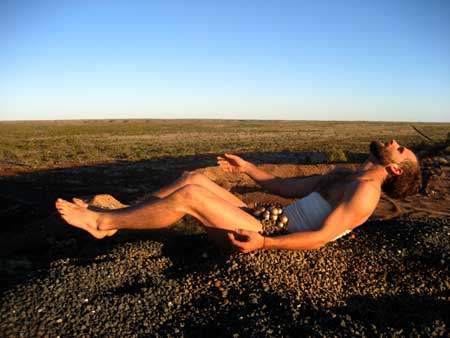 There is also a collaborative work, Dancing on the Scats, by Lofts and Hempel, unfinished at the time of Lofts’ death and brought to completion by Mahood. Lofts’ presence and absence is a kind of haunting, fitting the rather elegiac mood of the whole as it traces the past and wonders about the future in diverse yet complimentary ways.
There is also a collaborative work, Dancing on the Scats, by Lofts and Hempel, unfinished at the time of Lofts’ death and brought to completion by Mahood. Lofts’ presence and absence is a kind of haunting, fitting the rather elegiac mood of the whole as it traces the past and wonders about the future in diverse yet complimentary ways.
Right: Dancing on the Scats,by Pamela Lofts and Nic Hempel, a video compilation of still photographs of which this is one.
No longer productive the Groundrush mine is now being rehabilitated. It was owned by Newmont at the time of the residency but was acquired by Tanami Gold in 2010.
The five living artists spoke to their work last Saturday:
Kim Mahood, a writer, including of the award-winning memoir Craft for a Dry Lake, and visual artist who grew up in Central Australia, she now lives and works some of the time in the ACT but spends several months every year in the Tanami:-
I guess the most important thing about the work is how differently we all engaged with the mine itself. We found ourselves in a very unfamiliar environment, very much outside our comfort zone, so what came out of the work was a very strong bonding between us. We were all very supportive of what each other were doing. Even where there was not obvious collaboration, that was happening … At the same time each of us were negotiating a very different relationship with the place.
I have a very long connection with the Tanami, although I wasn’t familiar with the mines. Pam and I had been travelling out there often; Rachel had worked on a rig about 15 years ago; for Nic and Drew it was a first.
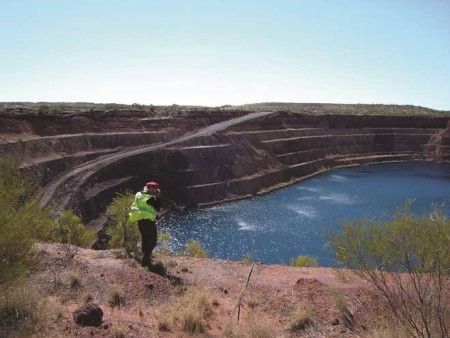
For me it was very much about the textures of the country itself. I guess we all had interesting responses as well to the fact that it was a mine. For some people that’s an immediately pejorative element. Over the couple of weeks that shifted because the site manager Roger Potts, who was managing the rehabilitation, was quite passionate about getting that right and had also been the environmental officer beforehand.
Left: Pamela Lofts at the mine pit. Photo by Pip McManus from the Groundrush archives.
Initially, when he got over the shock and panic of having six artists on site, he became really engaged with us, took us around to locations and was fascinated at the way we did respond. …
Being exposed to how Newmont in particular took seriously the rehabilitation and the responsibilities to the traditional owners was pretty impressive actually. I know that isn’t the case with plenty of companies but they were doing the best they could.
There was that sort of disjunct between the holes in the ground and what they represented and how beautiful they were. The patterning that kept re-emerging in the process of rehabilitating the dumps, these parallel contour lines that kept surfacing like the lines that you see in Indigenous painting – I kind of had the sense that the country had this underlying logic to it that kept resurfacing no matter how we were engaging with it.
Rachel Bowak, an artist with a focus on landscape and objects, paradox and polarity, she also lectures in art and design at Canberra Institute of Technology and Australian National University. She has worked for companies such as Fink & Co (manufacturers of Australian-designed objects), Thylacine (urban art, exhibition and industrial design), and Acacia Resources in the Tanami:-
I did quite a few things out there because I wasn’t sure how to engage or what was going to come from this. There are a few performance photographs [included in the show]. I dressed up as a French maid and was running around with my broom sweeping things up, a play-around with sorting out this landscape after it had been affected, in a futile way. Also I dressed up as a budgie and was pretending to land on the airstrip. But I don’t really have a performance background – I think that helped me enter the atmosphere.
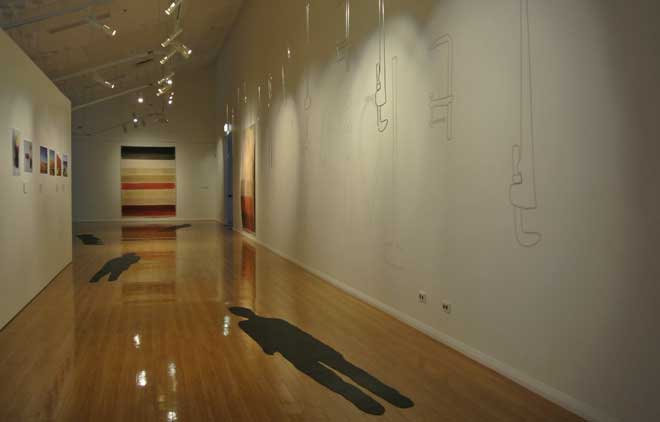
Installation view of Rachel Bowak’s stainless steel wire ‘drawings’ and Shadows; Kim Mahood’s Tanami Horizons (ochres, pigment and binder on canvas) on the far wall.
I traced people’s shadows onto the ground with black oxide and water, so that when somebody stepped away the shadow was there – there was this absence, a history of a previous presence. I think then absence started to be the thing that I was interested in working with.
The tools are all life-sized tools from the mechanics workshop at the mine. I’ve been doing line drawing with stainless steel of objects for a while now. I really like the way they become dysfunctional, I’ve taken the function away, I’ve turned them back into a symbol.
What I’m interested in with this work is … they way we affect our environment with the tools. They’ve become quite a strong symbol for me of the light and the dark side of our use of our intelligence, in making tools, using tools, affecting the landscape, but then there’s the dark side to that. I was more interested in the polarity that those sorts of instruments embody.
Pip McManus, a ceramicist increasingly drawn to employing other media in order to communicate to a wider audience. A long-time resident of Alice Springs, she is a founding member of Watch This Space, a frequent exhibitor in solo and group shows around Australia (and overseas), and a past winner of the Alice Prize (2008, for her video work, Ichor):-
The mine experience was an important opportunity to interact with a number of different artists and particularly Nic and I collaborated. I recorded Nic playing in various environments, sometimes with the acoustic cello, sometimes with the electric cello.
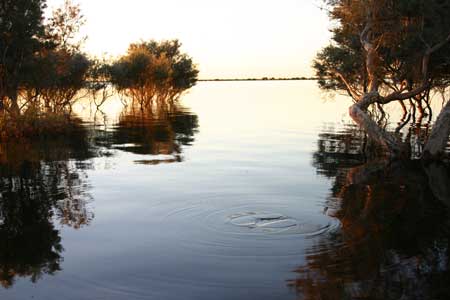 The things that stick in my mind about the whole experience are the disjuncture between the silence of the endless horizon and natural landscape, and the rhythm of that constant landscape that had been there for thousands of years and the sudden imposition of alien environments deposited on that land and the big holes in the ground.
The things that stick in my mind about the whole experience are the disjuncture between the silence of the endless horizon and natural landscape, and the rhythm of that constant landscape that had been there for thousands of years and the sudden imposition of alien environments deposited on that land and the big holes in the ground.
Left: Pip McManus, Lake Ruth, still photograph taken at the same time as the video for her and Hempel’s Lake Ruth Sonata, for which Hempel played in situ.
The music that Nic created seemed to fit very well with my notion of being an insignificant little alien dot there in this vast environment but also being aware of the fact that our position there and the interaction of mining has an affect on that landscape forever.
Nic Hempel is a physical performer and classically trained musician who lives in Alice Springs. He studied music in Tasmania and dance in Melbourne and Japan. His work melds music with visual performance for diverse audiences in unusual locations:-
I enjoyed taking two instruments out there, a regular standard cello, and the electric cello. The old cello was a representation for me of western music, western culture; the new instrument I had made just a couple of years before the Groundrush project. The project gave me the opportunity to explore it more and get feedback on it.
I loved having that old cello that I’ve got a big history with. I started playing it when I was nine and studied it at university and was passionate about classical music. Pip and I did some recording in a tank that was used to leach the gold out of the ore … they’re fantastic resonating chambers. I actually played Bach in there.
[McManus: The old cello that you can hear in Lake Ruth Sonata was recorded in the Rabbit Flat roadhouse, no longer functioning. It had a beautiful warm acoustic quality. The last segment is the actual recording we did at Lake Ruth, the only one synced with the visuals.
[Hempel was asked from the floor how the dance performance relates to the music.]
At the time I had been more involved in physical performance than in music. I had an injury, stopped playing for a while and danced instead. I studied Butoh in Japan, then performed with some companies in Sydney and Melbourne and then came to Alice Springs.
Perhaps the most active time for me in physical performance was when I met Pam. She got to know my physical performance before my music performance. She was really keen to do a collaboration out there and got me up before the sun one morning. It was bitterly cold. We went up to the scats, these mounds of grey [processed ore]. I did a series of short performances that she photographed. I was trying to allow the landscape to speak through the shapes and the movement of my body.
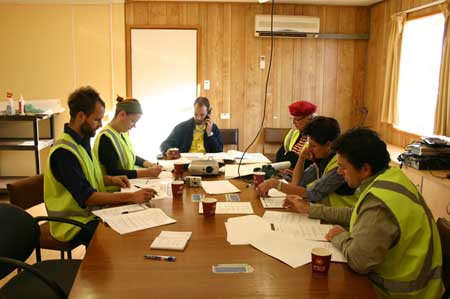 [Mahood: This was a sequence Pam had put together but hadn’t resolved which, among other things, I took on to try to make sure that she had a really strong presence in the show. Pam would be very happy it was there, but she would be saying ‘I would have done it better’. She’d already made a selection. Nic and I went through and edited it.]
[Mahood: This was a sequence Pam had put together but hadn’t resolved which, among other things, I took on to try to make sure that she had a really strong presence in the show. Pam would be very happy it was there, but she would be saying ‘I would have done it better’. She’d already made a selection. Nic and I went through and edited it.]
Right: The Budgies’ induction at the site. On the left Nic Hempel and Rachel Bowak; on the right Andrew Moynihan, Kim Mahood, Pamela Lofts; Pip McManus behind the camera.
The movement was most influenced by Body Weather, which is a dance form, a series of processes that draw on meditation and on improvised movement practices to try and embody different features of the environment or climate and use those features as stimulus for movement. For example, imagining a butterfly on your left shoulder … the sun rising in your foot, the sort of quality that might have.
[From the floor Hempel was asked whether his performance in Dancing on the Scats was self-directed.]
It was a collaboration with Pam. She’s behind the wrapping on my torso and the gold balls. They’re props that she gave me without saying very much [and she chose the site].
Andrew Moynihan was born in Sydney, the son of Irish parents who came to Australia in the 1960s. After years of wandering throughout Australia, he studied fine art at the University of Tasmania and Queensland College of Art. He now lives and makes art between Alice Springs and Brisbane, and recently spent a few years in Canberra:-
For me, more so these days than ever, art is interesting in what it attaches to. It might be interesting in how it attached to it but I’m normally interested in looking into something through someone’s art and becoming interested in what that is and how they’ve done that. …
In my early years I built houses, wooden pole houses, so I was immediately interested in the architecture out there, these quite beautiful open corridors, little rooms off to the side.
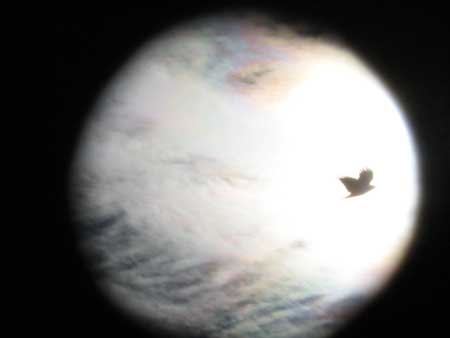 Another thing that had happened to me is that I’d spent some time in communes as an early adult. There was a lot of environmental activity going on, protesting, talking about the environment … It kind of overloaded me because it was up against these big corporations all the time … so when I was out there I was quite aware of the massive land thing and the mine but I think I’d already been through a lot of those confrontational thoughts …
Another thing that had happened to me is that I’d spent some time in communes as an early adult. There was a lot of environmental activity going on, protesting, talking about the environment … It kind of overloaded me because it was up against these big corporations all the time … so when I was out there I was quite aware of the massive land thing and the mine but I think I’d already been through a lot of those confrontational thoughts …
Left: Their whole ancestry is hidden by Andrew Moynihan.
I got interested in who these people were and their living spaces. I sort of felt sorry for miners in a way for being paid really well for doing time, for being out somewhere – maybe not everyone – counting down the days, when am I going to be home again. I was just really interested in these people and I hovered around the mine site a bit more.
I found these empty dongas that I was wondering around in and contemplating … quite beautiful when I realised that the foil [on the windows, to keep out the heat] was deteriorated and had these sprinkling lights. Coming into the rooms, I was closing them up and taking photographs of the light [patterns], they looked like constellations and universes. I started playing with those, then zooming out, thinking I’d look at the planets, and then realised that I saw this spinifex blowing the wind, and then I realised now I’ve got something I can explore. I enjoyed the idea of someone sleeping in these camera obscura-type [spaces], the outside world sprinkling across them.
Note: Kieran Finnane’s review of Groundrush will appear in a forthcoming issue of Artlink, a quarterly journal covering contemporary art and ideas in Australia and the Asia-Pacific.
Below: this dark thing by Pamela Lofts.



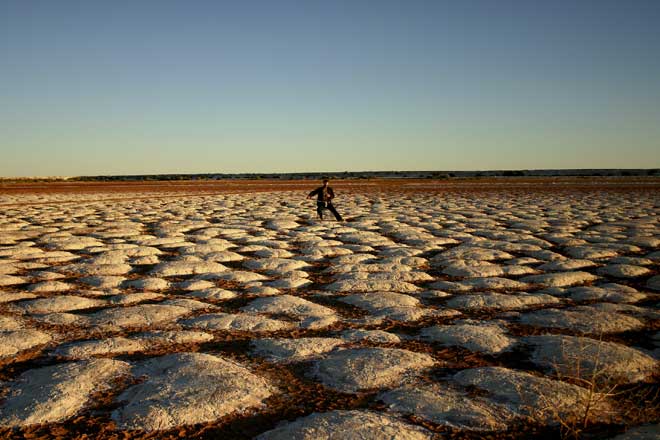

Terrific piece Kieran. Great to have a long review, contextualising the art and the artists. The show looks amazing.